Motorcycle.com

Get the Flash Player to see this player.
Getting your older brother's or sister's hand-me-downs is never as fun as getting your own stuff like a spankin' new pair of canvas Chuck Taylors! But if you look up to your siblings you feel honored to finally get what they had because they're so cool in your eyes.BMW motorcycles have a similar pass-along pattern when some new electronic wizardry is introduced on a particular model, but it's more like trickle-down than hand-me-down. In the case of the 2008 R1200GS and GS Adventure, finally getting what all your mates had is good; getting an even better version is great. Along with a myriad of refinements some minor, some substantial the bike(s) that many consider to be top dog in adventure-touring now have, for the first time, an enhanced version of BMW's ESA (Electronic Suspension Adjustment) as available equipment. It's called Enduro ESA, and it's ready for the ruggedness of the world. Also, this would be our first opportunity to sample BMW's ASC (Automatic Stability Control) on an R1200GS.
In case you're not familiar with the GS and GS Adventure, think of them as the Humvee of the motorcycle world. They've developed a reputation of being the bike to have for taking the "long way 'round" on two-wheeled trips that span continents, if not the entire globe. Both bikes have the same basic platform of an air-oil-cooled 1,170cc OHV four-valve Boxer Twin as a stressed member in a tubular-steel trellis frame riding on a 19-inch front and 17-inch rear wheel. Suspension is the German bike maker's unique Telelever up front and Paralever out back.
Key to differentiating between the two models is the Adventure's cavernous 8.7-gallon fuel tank a full 3.4 gallons more than the GS 0.8 inch more suspension travel, 1.7-inch taller adjustable seat height (35.2"-low; 36"-high), spoked wheels, hand guards (two-tone color for '08), larger windscreen, off-road style wide-platform footpegs and crash guards for the fuel tank and cylinder heads. Clearly, then, the Adventure is ready for what its name implies. Maybe that's why Ewan McGregor and Charley Boorman opted for a pair of them on their transcontinental Long Way Down jaunt.
Though the GSA is more ready than the GS for the long-haul over the rough stuff, both bikes received a revised mill good for a 5-percent boost in power with a claimed 105 hp at 7,500 rpm, an unchanged 85 ft-lbs at 5,750 rpm (up 250 rpm), and a new 8,000-rpm redline, up from 7750 rpm. Despite BMW staff referring to it as an "all-new" engine, they weren't talking specifics, either in person or in press materials, but at least were willing to generalize, saying that pistons, cams, airbox, exhaust and engine management, to name a few items, were new or updated.
What they were touting, however, was a stiffer 6-speed gearbox borrowed from the HP2 Sport. The GS has slightly shorter transmission ratios to capitalize on increased engine output as well as a slightly shortened secondary gear ratio. The Adventure also received shorter gear ratios and has as an "enduro" gearing option; first gear is 10-percent shorter to better enable slow-speed crawling, allowing you to modulate the throttle without having to constantly feather the clutch to pick your way around and through technical terrain. Additional tranny improvements include enlarged bearing diameters and changed shaft distance. The standard GS also has a new shift shaft for smoother, more precise action.
The look of the bikes changed a wee bit as well. I'd call them refinements rather than big changes. The fender was tarted up a bit, the material on the leading edge, or guard, of the GS' fuel tank is now aluminum, and the cylinder heads and Paralever tubes have a magnesium color (black on the GSA) for greater contrast with the colors of painted surfaces. Grrr! It's supposed to look tougher. Other changes include a new aluminum conical handlebar with new adjustable clamps; the more forward of the two positions aids aggressive stand-up off-road riding. More foam has been added to the front portion of the GS' saddle, and it now enjoys the same 720-watt alternator as on the GSA. Finally, both bikes have LED tail lamps and indicators. That's the gist of the technical updates to the GS and GSA for '08. Now for the goodies.
BMW motorcycles are known for durability, reliability and, in the past several years, for a multitude of electronic gadgetry. From heated seats and grips to electronic tire pressure monitoring, Beemers can be loaded with optional tech-ie treats. These two inspirational motorcycles now enjoy the same trick ESA as an available option for many street-only models, but it's even more robust in this version. Called Enduro ESA, the push-button suspension has settings for pavement, and are displayed in the same manner as the street-oriented ESA. Load options are solo rider, rider with luggage, and passenger with three damper modes (Sport, Normal, and Comfort). Note that in all its street settings the front spring preload is always at the minimum. And like on the street bikes, there are little helmets and suitcases on the LCD portion of the dash to indicate your selections. Where the Enduro ESA takes one step further is with settings specifically for rugged terrain.
The Enduro portion of ESA has what are called Medium Reserves and Maximum Reserves # a small "mountain range" symbol in the LCD indicates the former, a larger symbol for the later. After choosing between Reserves, your next job is to select from Soft, Norm and Hard. In the Medium setting, front and rear preload will be increased to 50% of its adjustment. In the Maximum setting front and rear preload is 100%. Ground clearance in Maximum mode is approximately 20mm higher than in the solo rider on-road mode. When it's all said and done, a total of 15 suspension settings are possible with Enduro ESA.
I found my best experience with the Enduro ESA in the Medium Reserves setting with either a Norm or Hard selection depending on how gnarly the terrain. Conversely, the same selections in Maximum reserves often resulted in damping too harsh for my tastes and limited dirt experience.
2008 GS and GSA Pricing: Mostly unchanged but still spendy
Everyone, including BMW, knows that the big GSs are a pretty serious investment of coin # even at the hand-crank window level. But in a twist of wallet-loving fate, the GSA retains its base price of $16,600 from 2006, and it seems the GS has actually come down approximately 100 clams from its 2006 MSRP of $14,700. Base prices exclude a $495 destination charge. Something else everyone, including BMW, knows is that virtually no one is going to buy a boring bare-bones bike from the German manufacturer. So, in an effort to ease add-on purchasing quandaries, three trim levels exist. Other extras not part of a package include: Alarm system ($235); Integral ABS II ($1,100); and spoke wheels for the standard GS are $495.
2008 R1200GS (Nambia Orange, Tanzanite Blue, Titan Silver Metallic, Slate Gray Metallic)
Safety Package # $1,650
- Tire pressure monitor, Integral ABS and ASC
Equipment Package I # $695
- Heated grips, on-board computer, hand protection, bag mounts
Equipment Package II # $1,495
- Chrome exhaust, ESA, heated grips, on-board computer, hand protection, bag mounts
2008 R1200GS Adventure (Magma Red, Magnesium Metallic)
Safety Package # $1,650
- Tire pressure monitor, integral ABS and ASC
Equipment Package 1 # $950
- Chrome exhaust, heated grips, on-board computer, peripheral headlights
Equipment Package 2 # $1,495
- Chrome exhaust, heated grips, on-board computer, peripheral headlights, ESA, case mounts for aluminum hard cases
Should you choose optional ABS when purchasing a GS, and we imagine most everyone would, you can also add BMW's ASC (Automatic Stability Control). ASC is what you're guessing it probably is. You can read in more detail about the system in our Three Naked Euros comparison, but in essence the ECU monitors wheel speed sensors and cuts power if the rear wheel starts spinning faster than the front. Take note that ASC is only available with ABS, and both can be disabled with something slightly more complicated than a single push of a button with the bike stopped and in neutral. The disable process isn't frustratingly complex, but you'll want to make a few practice runs to ensure you're proficient before you set off to unpaved territories. You dirt veterans already knew that a rider needs to spin and slide in the gravel, sand and loose stuff, didn't you? No ASC or ABS here if you know what's good for you.
With ASC enabled only during on-pavement sessions, and nothing but dry roads around, it was difficult to judge the ASC. The only times I felt it intervene were during hard acceleration and wheelie attempts. Getting on the gas and fanning the clutch would only result in the bike lurching
forward with a stumble and sputter from the electronics cutting in and spoiling the wheelie. It was quite evident that the bike's brain wasn't having any of it. With the ASC switched off, playing adventure-riding hooligan had the front skyward in no time.
What they're made for
The deserts of Arizona can be both stunningly beautiful and treacherously rugged. Maybe that's why BMW NA regularly chooses such an environment for letting the media sample from the company's rapidly expanding Enduro line.
Fountain Hills, AZ, is a pleasant community situated approximately 30 minutes northeast of the Phoenix and Scottsdale areas. Snugged up against a hillside, the Inn at Eagle Mountain, with its tranquil, picturesque desert scenery encompassing the grounds, served as both starting and finishing points for two days of riding. Towering saguaro cactus # the kind that typify what most people think of when they imagine the Old West# sit right next to some of the Inn's suites. A variety of smaller cactus, as well as various desert plants that were blooming in all their springtime glory, dot the rest of the facility. Mix in the dry reddish rock that makes up much of the soil in this part of the country, and there's no question you're in the desert.
Ride routes consisted of a sufficient mix of both pavement and harsh dirt roads that most certainly require a skillful operator at the helm of a four-wheel-drive vehicle, if any vehicle other than capable motorcycles or ATVs were to use the road. With plenty of dry washes and shallow streams, rocky uphill sections flanked on either side by sandy troughs and just enough hard-pack sections to occasionally relax tired muscles, the first day's GS Adventure route was challenging. We worked our way up SR-87 with 4 Peaks in the Tonto Basin as a pivot point. Connecting to SR-188 and passing by Theodore Roosevelt Lake we got a short, but much-needed pavement respite before picking up SR-88 that eventually brought us by the sweeping vistas of Pinyon Mountain, Horse Mesa Dam and eventually to and through serene Canyon Lake. Apache Junction and Stewart Mountain were the last notable areas before returning to the now-more-pleasant-than-ever Inn for a sorely-needed, icy-cold adult beverage.
Through all the trials and tribulations whilst tackling this sometimes-unforgiving route, with its jagged rocks and painful prickly pear cactus taunting me from the road's edge, one basic thought underpinned everything else I contemplated: The height and weight of this mechanical animal could prove to be, at times, its most valuable asset or the ultimate demise of an otherwise successful journey. So long as I could keep it moving, no matter how slowly thanks to the new lower first gear and smooth fueling that allowed access to the plentiful torque I could surmount any obstacle or situation that I chose (stress chose here).
The unhelpful heft up high of the extra fuel carried by the Adventure's larger tank, and the poor balance that it can create given a precarious enough situation, only fed into the threatening image the ominous petrol holder presents when looking down on it from above as you struggle feverishly to keep the bike top-side up. Combine the 60-pound claimed wet-weight penalty (564 vs. 504 lbs.) with the extra ride height from the additional suspension travel and taller saddle, and the GSA's size demands the respect that a skillful, seasoned dirt rider or anyone over 6-feet tall can give it. As I said, however, these very same traits can serve the rider well. A deft throttle hand and judiciously applied brake can take the big bike through, around or over virtually any terrain. But we know this already because the GSs are iconic to charting regions untouched, both in reality and in the soul.
Time spent on the pavement-loving GS on day two had me admiring its qualities as well as missing the amenities of the Adventure. The Adventure's taller and wider screen offers more protection from wind (and rocks!) without much turbulence, and its wide off-road-style pegs were sorely missed during long stand-up sessions. But I gladly embraced the lower ride and seat height of the standard GS.
Though sounding clunky upon shifting, the revised tranny was trouble-free and smooth. Clutch action at the lever in the first quarter pull or so of engagement is firm, with a light effort past that point.
In terms of handling, the standard GS is fully competent in accepting the task of packed gravel or properly maintained fire roads. Yet there is a stark contrast in the way the two bikes reward the challenge of twisty tarmac. The Adventure's knobby Metzler Karoo tires (Coo coo ca choo, I am the GS!) are the business in the rough and tumble but make it an unwilling participant in tight canyon carving. A very direct and constant pressure is needed on the inside bar to keep the thing turning in a smooth arc. By all accounts the off-road tires and extra weight of the bike seemed to be the likely culprits. Contrast that with the lighter GS and its street-oriented tires, and they feel like two very different bikes. Steering on the standard GS is light and the front feels secure; much more familiar feelings for the pavement.
As for the purported 5% poke in power, I wish my seat-o-the-pants dyno could pick up on the increase, but it couldn't. Did I note a slightly revv-ier engine? Yes.
I over heard a grumpy comment or two from a couple of the curmudgeons hopelessly devoted to dirt riding as they lamented the weight and overall size of both bikes as major drawbacks to off-road performance. They further murmured that the KTM Adventure is a better handler. What I didn't respond with and thereby avoided getting into a peeing contest was that we have to remember that the GSs aren't off-road motorcycles but are motorcycles that can go off-road. Once you're willing to reconcile any pure dirt experience you have and the presumptions made from it with that paradigm shift, then you can accept that these machines are capable of far more than what most are willing to admit, let alone attempt.
Pete's Adventure Panoply
SHIFT Combat boots, Squadron Pant, XC Jacket, Strike Glove, HJC CL-MC5 helmet and Scott goggles.
Related Reading
2006 BMW R 1200 GS Adventure
2007 BMW G650 X Series
Review: 2005 BMW R 1200GS

Motorcycle.com presents an unrivaled combination of bike reviews and news written by industry experts
More by Motorcycle.com Staff



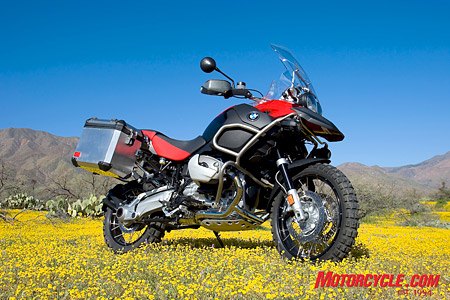















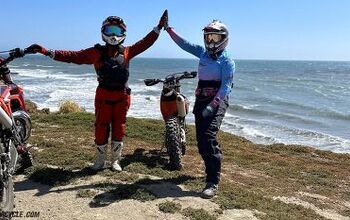
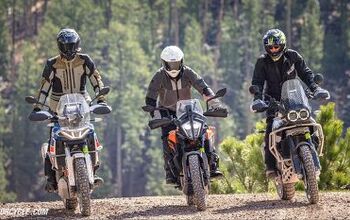

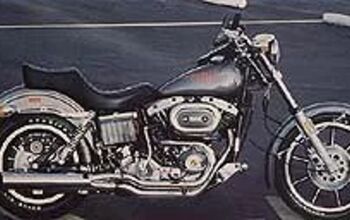







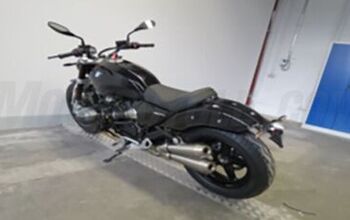






Comments
Join the conversation